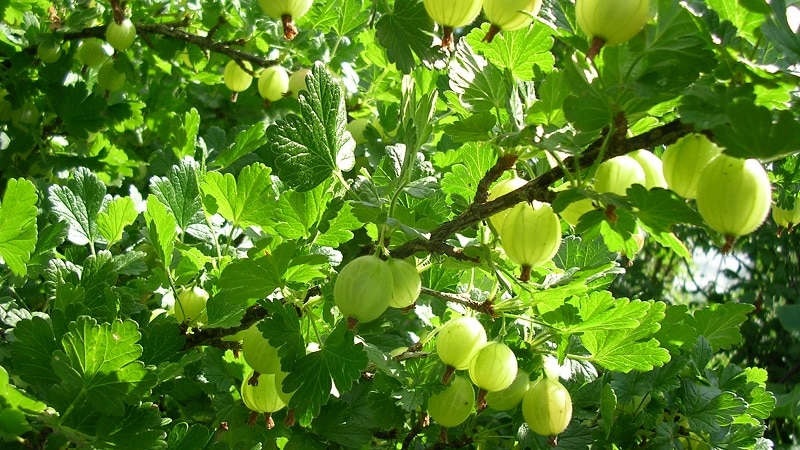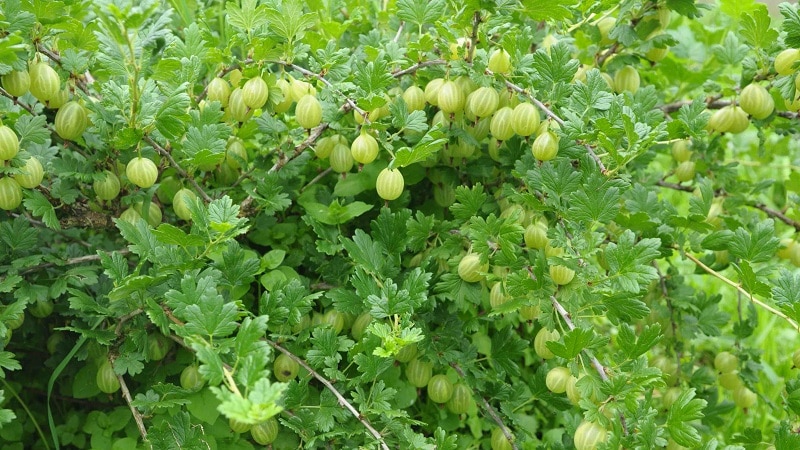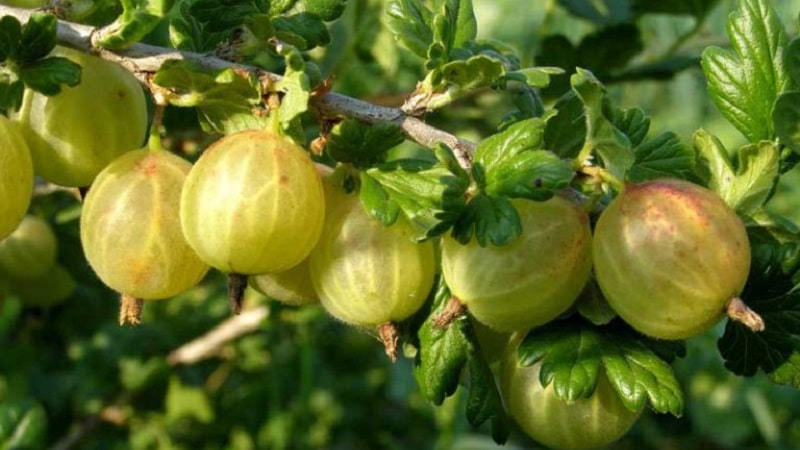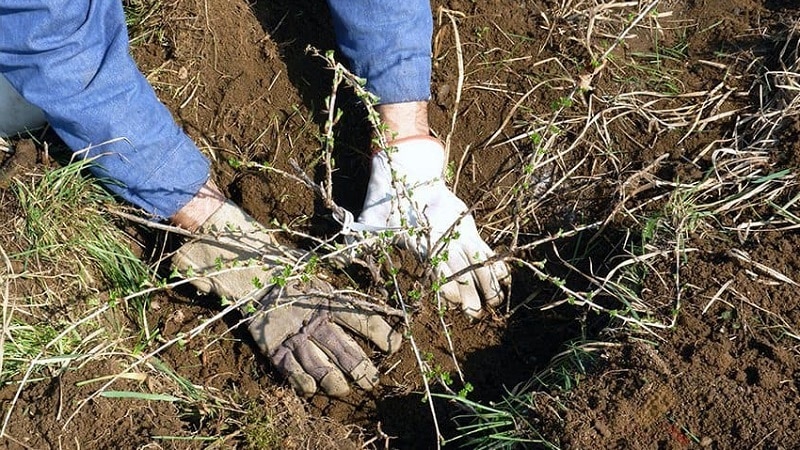Excellent-tasting and weather-resistant gooseberry variety Rodnik
Gooseberry Spring belongs to one of the the best varieties culture. It will deservedly take pride of place in the garden thanks to simple growing methods and large fruits with excellent taste characteristics. You will find a detailed description of the variety in the article.
What kind of gooseberry is this?
The variety was obtained by crossing the mid-early gooseberry Lada and a seedling from free self-pollination Purmen. Moscow breeders I.V. Popova and M.N. Simonova managed to combine many positive properties in one plant.

In 2001, the variety was included in the State Register as recommended for cultivation in the Central region of Russia. It is cultivated in the middle zone, the European part, and in the southern regions. The Rodnik gooseberry demonstrates its maximum fruiting abilities in the Moscow, Tula, Ryazan, Vladimir, Bryansk, and Smolensk regions.
Gooseberry Spring: characteristics and description of bushes
The plant forms compact and dense bushes 1.2 m high with drooping tops and straight thick branches that change color from green to dark gray as they grow. Few, sparse thorns (1-2 per 40-50 cm) of medium thickness, up to 11 mm long, are concentrated mainly in the lower parts of the stems, at a distance of 20 cm from the root.
The buds are brown, large, oval in shape and deviated from the shoot.The compressed crown is formed by large green five-lobed leaves with wavy edges, a slight shine and a leathery surface, pubescent below. Flowers of different sexes are large, cone-shaped, collected in 2-3 pieces. at each leaf node. The sepals are light green with red-lilac streaks.
Reference. Gooseberry Spring bears fruit in the second year after transplanting to a permanent place.

Temperature resistance
Rodnik borrowed high frost resistance from its parent varieties. The plant is resistant to sudden temperature changes and survives severe frosts down to -35°C. Spring frosts do not damage the flowers. If the shoots freeze during the growing season, the bush fully increases its green mass and root system.
Moisture and drought resistance
The drought resistance of gooseberries is average, which is typical for almost all plants with a superficial root system. Lack of moisture affects the fruits: they lose weight, density and become sour.
Resistance to diseases and pests
The variety is characterized by a high level of resistance to infections and gets sick extremely rarely. The only pest that parasitizes the bush is aphids.
Characteristics and description of fruits
Large oval berries yellow-green in color with veins as they ripen and acquire a reddish tint on the sides. The outer skin is thin but durable, with a slight waxy coating. The weight of the fruit is uneven, ranging from 4 to 7 g.
The aromatic and juicy green pulp with a small number of small seeds has a harmonious sweet and sour taste and contains 7.3% sugars and 2% acid. Tasting score: 4.9 points.
Reference. The average yield, according to long-term observations, is 7.5 kg per bush.
Areas of use
Ripe berries used both fresh and frozen. They are used to make jam, preserves, compote, marinade, and wine.

Advantages and disadvantages of the variety
Gooseberry benefits:
- good rooting ability;
- high, stable yield;
- early ripening;
- a small number of thorns;
- resistance to frost and temperature fluctuations;
- excellent taste of berries;
- self-fertility;
- stable immunity to major diseases;
- versatility of fruits;
- good transportability;
- long shelf life.
Disadvantages of the variety:
- ripe the berries are falling off after the rain;
- average resistance to aphids.
Growing technology
Gooseberry not picky about soil, feels good on all types, except sour and waterlogged ones. When groundwater is closer than 1-1.5 m, the plant is depressed and may die, and during prolonged drought it does not form flower buds and sheds its leaves. The crop is planted in soil heated to +6°C.
Bushes do not like thickening and shading, with a lack of lighting, development is inhibited, resistance to diseases and pests is reduced. The quality of the berries deteriorates and ripening occurs unevenly.
It is advisable to plant gooseberries in flat, well-lit, sunny, draft-protected areas, avoiding low spots and shade. The best predecessors are vegetables and strawberries. It is not advisable to plant after raspberries and currants.
Landing dates and rules
Landing better in autumn or early spring before buds bloom on the branches. Seedlings with a closed root system are planted even in summer:
- the size of the hole depends on the size of the root system; for a young plant, the optimal parameters are 40x40x40 cm;
- roots longer than 20 cm are removed;
- for planting, prepare a composition of organic matter, peat, wood ash and sand;
- drainage and ½ part of the nutrient mixture are placed at the bottom of the hole;
- the seedling is placed vertically or at an angle in the center;
- pour out the rest of the substrate and compact it;
- water, mulch;
- shoots are pruned to the level of 4 fruit buds.

Further care
Further care consists of moderate watering, the frequency of which depends on weather factors. The indicator for its implementation is dry soil in tree trunk circles. If there is excess rain, a drainage ditch is dug at a distance of 30 cm from the trunk to drain excess water. The crust on the soil surface is destroyed by shallow loosening. At the same time, weeds are removed.
The bush is formed 10-13 stems. Health pruning is carried out in early spring, removing damaged and dry shoots. Trunks older than 8 years are pruned at the root. After picking berries Gooseberries are thinned out and twisted branches are removed.
From the second year of life the plant is fed: in the spring - nitrogen fertilizers, during the period of fruit ripening - organic.
Possible problems, diseases and pests
In cold, rainy summer conditions, a fungal infection may appear, which manifests itself as a bluish coating on the berries. To prevent infection, gooseberries must be treated with fungicides in the spring.
The plant may be exposed aphid infestation. To avoid this, timely spraying with any insecticide is required.
Wintering
For the winter, the bush is collected in a bundle and tied so that the shoots do not break from the snow. Carry out the last watering, hill up and cover with a layer of mulch.

Reproduction
The main methods of propagation are cuttings, the use of layering, and dividing the bush.
In June, cuttings 12-15 cm long are cut and planted to a depth of 1.5 cm in fertile, moist soil under a film cover, watering periodically.
Gooseberry Spring can be propagated by layering. A strong young shoot is bent down and covered with earth. In spring, rooted stems are cut off and planted.
Reference. The most productive way is to divide the bush.
Reproduction must be carried out in the spring, around mid-May. Separate bushes that are at least 4 years old. The plant responds well to transplantation and quickly takes root.
Features of growing gooseberries Rodnik depending on the region
In the middle zone and to the north, you need to choose the sunniest places for planting; to the south it is better to find openwork shade for the bush so that sunburn does not damage the foliage and crop.
Autumn planting in cold zones is carried out a month before the arrival of frost, in temperate climates - in early September, in warm regions the period is extended until mid-October. In areas with a variable climate, it is advisable to plant in spring. The optimal time for central Russia is mid-May, for the southern regions - April.
Pollinator varieties
Gooseberry Spring does not need pollinators. Even a single plant will bear fruit, since the variety is self-fertile.
Reviews from summer residents
 Summer residents who grow Rodnik on their plots note the variety’s high yield and resistance to disease.
Summer residents who grow Rodnik on their plots note the variety’s high yield and resistance to disease.
Elena, 52 years old: “An excellent variety for those who want to collect large, moderately sweet berries gooseberries. There is some sourness in the taste, but it is insignificant compared to many other types. I’m happy with the gooseberries, I’ll try to propagate them.”.
Vladimir, 46 years old: “The Rodnika bush has been growing on my site for 5 years and meets the varietal characteristics.Over the years there have been no problems with diseases or pests. Productivity is good every year".
Conclusion
The spring belongs to the high-yielding selection varieties of gooseberries. The bush has a compact size, an excellent degree of frost resistance, and is unpretentious in cultivation and care.
The universal-purpose berries have an excellent taste; on a five-point scale they received a tasting score of 4.9. The crop can be grown both in temperate climates and in warm regions. The fruits are well transported and stored for a long time.